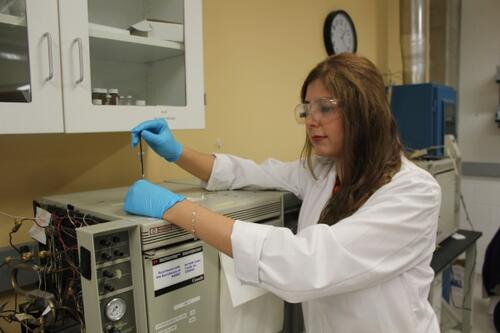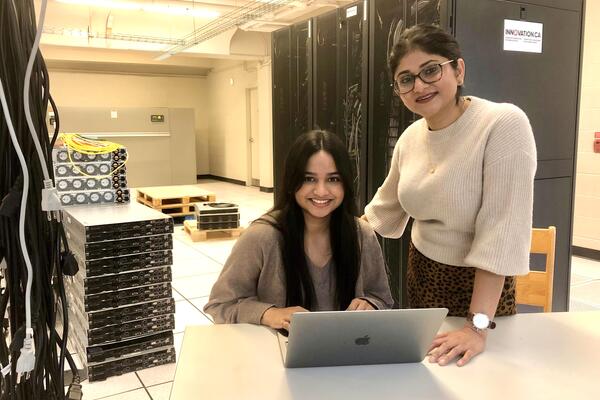
Leapfrogging ahead of competition with engineering research partnership
The fruitful partnership between Professor Bill Anderson's research lab and Class 1 Inc.

The fruitful partnership between Professor Bill Anderson's research lab and Class 1 Inc.
By Angela Pause Faculty of EngineeringThe partnership between Prof. Bill Anderson’s chemical engineering research lab at the University of Waterloo and a local manufacturer of medical gas recovery units is a fruitful one. “In fact, Bill Anderson and his team have given us a worldwide competitive advantage,” says Marian Marshall, Vice President of Operations at Class 1 Inc., in Cambridge, Ontario. “With Bill’s research we have leapfrogged five years ahead of the competition and have invented an innovative anesthetic gas recovery solution for hospitals and medical facilities worldwide.”
Anderson’s research lab helped Class I with a notoriously difficult problem; what to do with the anesthetic gases (volatile halogenated hydrocarbons) that patients exhale during surgery. With only a fraction of these gases absorbed or metabolized by the patients, hospitals have collected the excess gases in their exhaust systems and, with no other option, vented them outside, usually through a rooftop pipe. These expelled halogenated hydrocarbons contribute directly to global warming and stratospheric ozone depletion.
“The operating rooms of a single hospital emit the greenhouse gas equivalent of 2,000 vehicles per year,” says Marshall. “Globally, this equals about 12 million vehicle emissions each year and these particular gases are 3,000 times more harmful than carbon dioxide. Nothing existed to safely capture these gases.”
That is until Class 1 Inc.’s president, Barry Hunt, dropped by Bill Anderson’s chemical engineering laboratory one day a few years ago. “Barry had read about my research online and just came to my office and said he needed my help because there was no one else working on this problem,” says Anderson.

Anderson’s research, along with graduate student Mina Mehrata, led to the invention and manufacturing of a centralized halogenated drug recovery (HDR) process that captures and safely stores the gases, with the intention of recycling and reusing it as the research progresses, says Marshall. With initial funding from a Natural Science and Engineering Research Council (NSERC) grant as well as the Ontario Centres of Excellence’s Voucher for Innovation and Productivity (VIP) program, Anderson and his team were able to develop a process to capture the gases on site. Mehrata used her research on the hospital air emissions recovery process as the basis for her master’s thesis, and is working closely with another Waterloo chemical engineer, Leila Emami Taba, and Class 1’s engineers in developing the commercialized version of the HDR unit.
“We couldn’t have done any of this without Bill Anderson’s team of chemical engineers at the University of Waterloo.”
An expert in heterogeneous catalysis and process engineering as applied to environmental engineering problems, Anderson, says Class I is a great industry partner as they are receptive to new ideas and move quickly to make things happen. Today an HDR unit is installed in the Grand River Hospital in Kitchener-Waterloo, with California’s Stanford University Medical Center in California, and several other healthcare facilities preparing for their units. As hospitals learn of the benefits and as legislation insists on halogenated drug recovery as an environmental protection measure, Class I is poised to dominate the market, says Marshall. “We couldn’t have done any of this without Bill Anderson’s team of chemical engineers at the University of Waterloo.”
Industry collaboration is something that Anderson views as essential – his research has tangible, real-world benefits that contribute to improving environmental conditions. As one of 130 researchers at the University of Waterloo’s Centre for Bioengineering and Biotechnology , (CBB) which works to advance bioengineering and biotechnology research and innovation through industry collaborations and partnerships, Anderson and his research team has become vital to Class 1’s business strategy in bringing new products to the market. He’s their “not-so secret weapon”.

Waterloo researcher Dr. Tizazu Mekonnen stands next to a rheometer, which is used to test the flow properties of hydrogels. (University of Waterloo)
Read more
Plant-based material developed by Waterloo researchers absorbs like commercial plastics used in products like disposable diapers - but breaks down in months, not centuries

Read more
Here are the people and events behind some of this year’s most compelling Waterloo stories

Engineering master's student Nayeema Nonta (left), one of the three paper authors, and her supervisor, Dr. Sirisha Rambhatla, in a large server room with the computer power needed to develop their new LLM training technique. (University of Waterloo)
Read more
Waterloo researchers develop highly efficient AI training system that paves the way for cheaper, greener “intelligent partners”
The University of Waterloo acknowledges that much of our work takes place on the traditional territory of the Neutral, Anishinaabeg, and Haudenosaunee peoples. Our main campus is situated on the Haldimand Tract, the land granted to the Six Nations that includes six miles on each side of the Grand River. Our active work toward reconciliation takes place across our campuses through research, learning, teaching, and community building, and is co-ordinated within the Office of Indigenous Relations.